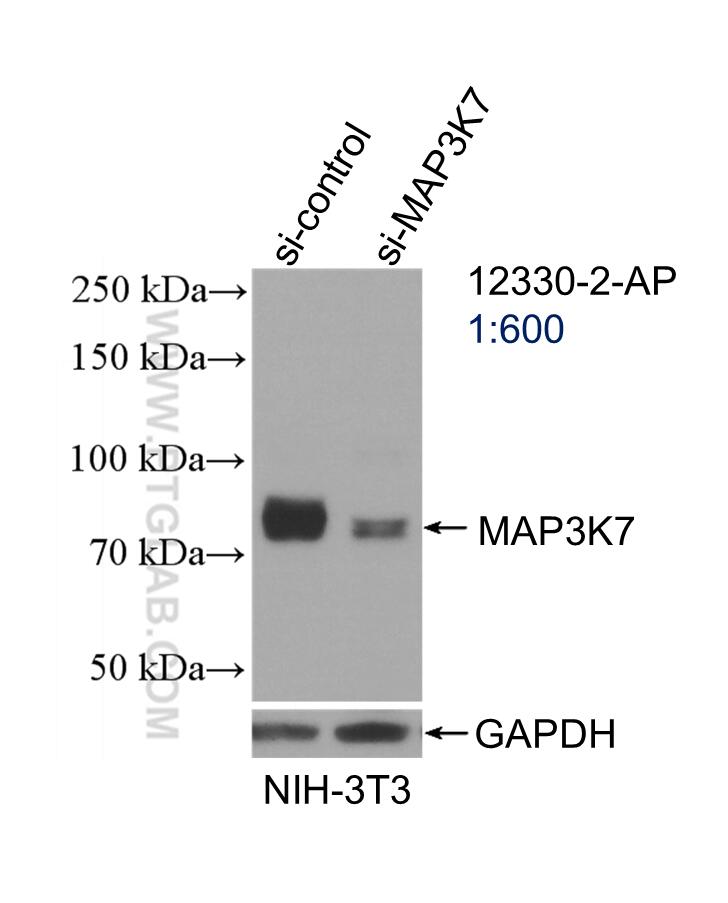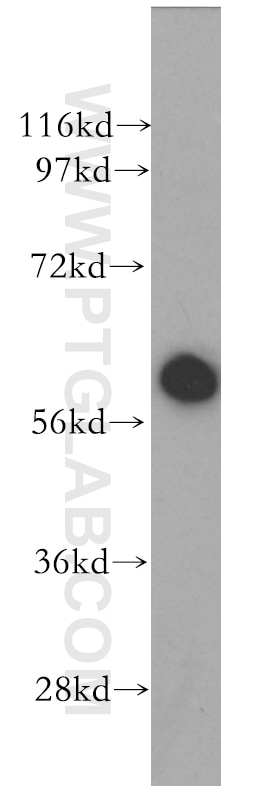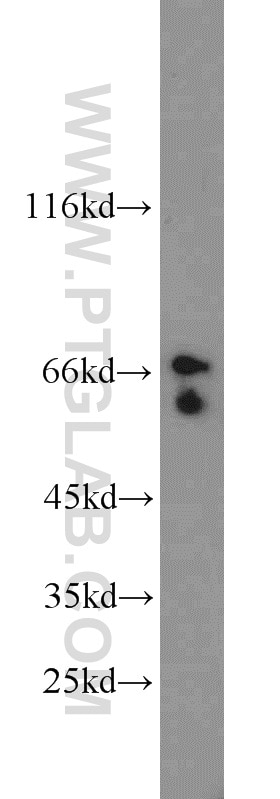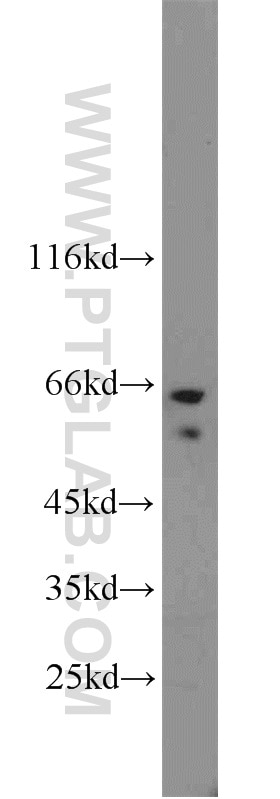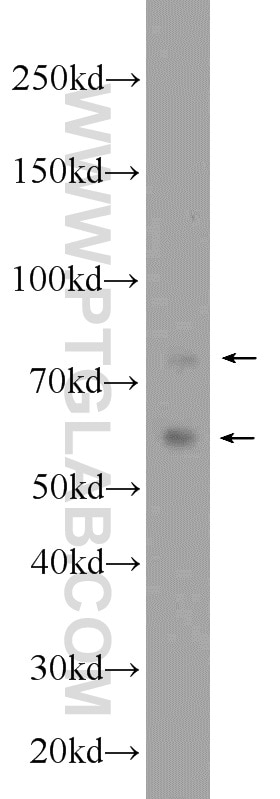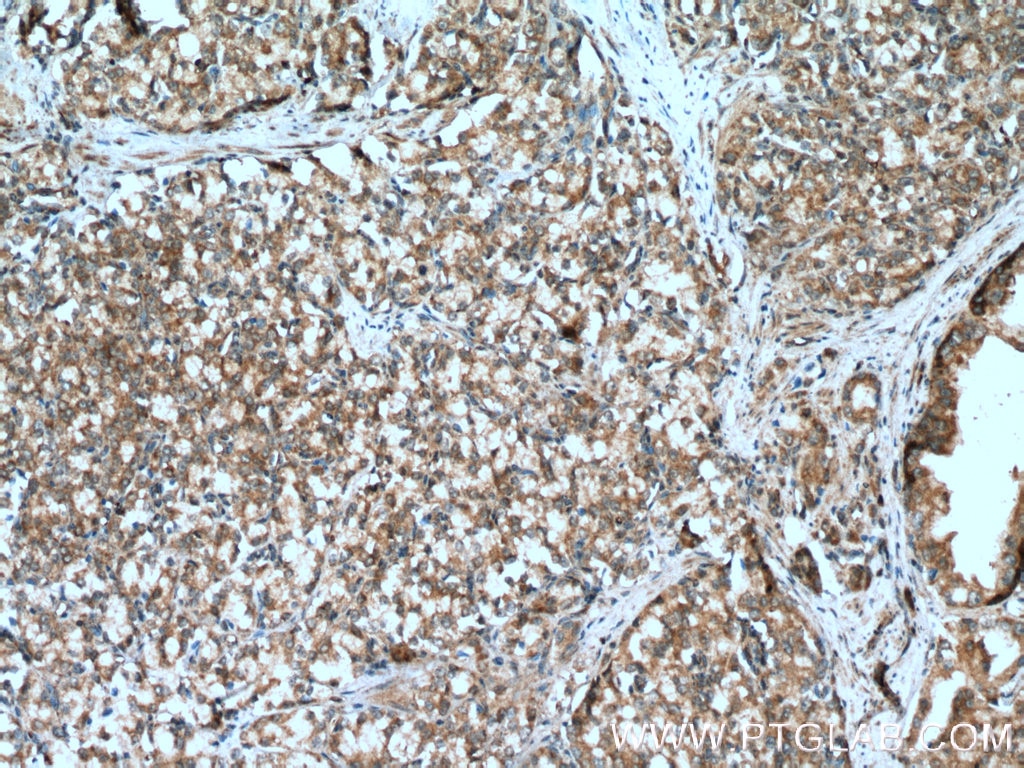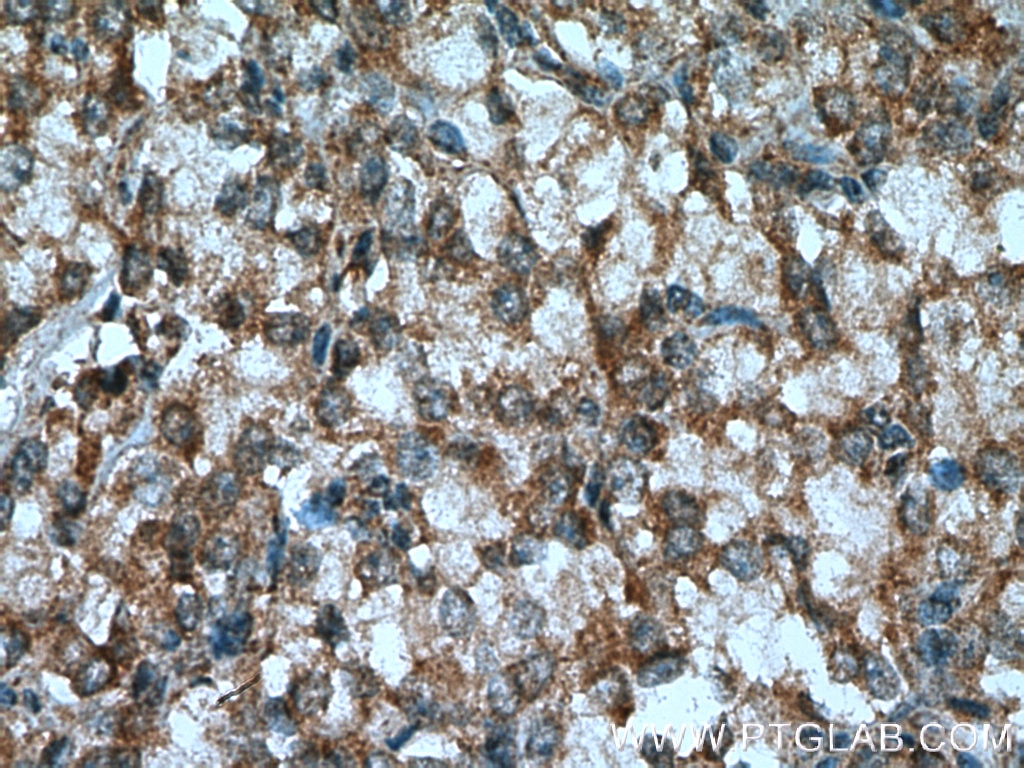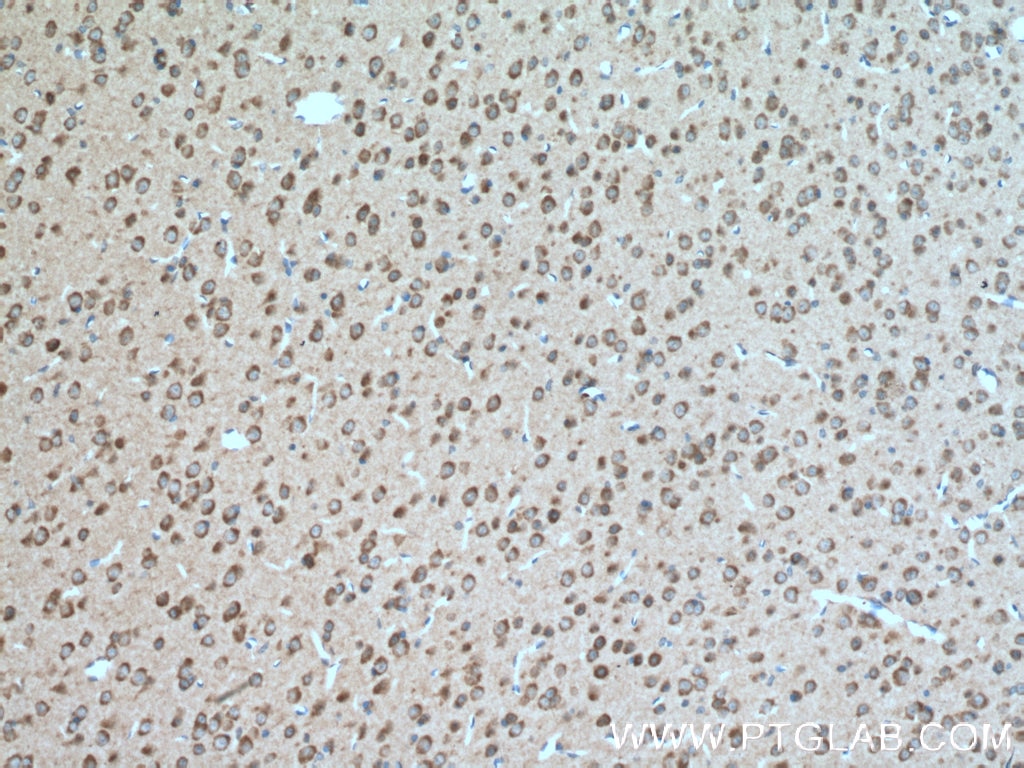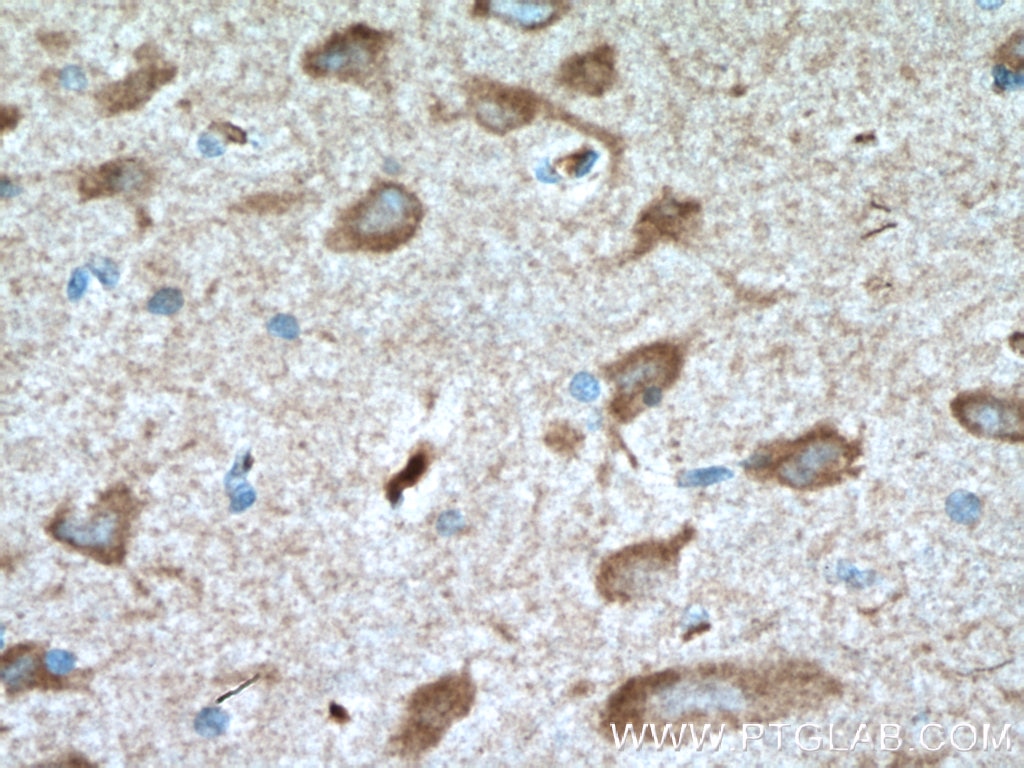Tested Applications
| Positive WB detected in | NIH/3T3 cells, K-562 cells, SKOV-3 cells, COLO 320 cells, A375 cells, A431 cells, CHO cells, MCF-7 cells, HeLa cells, mouse heart tissue, A2780 cells |
| Positive IP detected in | NIH/3T3 cells |
| Positive IHC detected in | human prostate cancer tissue, human brain tissue, mouse brain tissue Note: suggested antigen retrieval with TE buffer pH 9.0; (*) Alternatively, antigen retrieval may be performed with citrate buffer pH 6.0 |
| Positive IF/ICC detected in | NIH/3T3 cells |
Recommended dilution
| Application | Dilution |
|---|---|
| Western Blot (WB) | WB : 1:500-1:1000 |
| Immunoprecipitation (IP) | IP : 0.5-4.0 ug for 1.0-3.0 mg of total protein lysate |
| Immunohistochemistry (IHC) | IHC : 1:100-1:400 |
| Immunofluorescence (IF)/ICC | IF/ICC : 1:50-1:500 |
| It is recommended that this reagent should be titrated in each testing system to obtain optimal results. | |
| Sample-dependent, Check data in validation data gallery. | |
Published Applications
| KD/KO | See 3 publications below |
| WB | See 54 publications below |
| IHC | See 2 publications below |
| IF | See 2 publications below |
| IP | See 5 publications below |
| CoIP | See 4 publications below |
Product Information
12330-2-AP targets TAK1 in WB, IHC, IF/ICC, IP, CoIP, ELISA applications and shows reactivity with human, mouse, hamster samples.
| Tested Reactivity | human, mouse, hamster |
| Cited Reactivity | human, mouse, rat, pig, fish |
| Host / Isotype | Rabbit / IgG |
| Class | Polyclonal |
| Type | Antibody |
| Immunogen |
CatNo: Ag3041 Product name: Recombinant human MAP3K7 protein Source: e coli.-derived, PGEX-4T Tag: GST Domain: 1-291 aa of BC017715 Sequence: MSTASAASSSSSSSAGEMIEAPSQVLNFEEIDYKEIEVEEVVGRGAFGVVCKAKWRAKDVAIKQIESESERKAFIVELRQLSRVNHPNIVKLYGACLNPVCLVMEYAEGGSLYNVLHGAEPLPYYTAAHAMSWCLQCSQGVAYLHSMQPKALIHRDLKPPNLLLVAGGTVLKICDFGTACDIQTHMTNNKGSAAWMAPEVFEGSNYSEKCDVFSWGIILWEVITRRKPFDEIGGPAFRIMWAVHNGTRPPLIKNLPKPIESLMTRCWSKDPSQRPSMEEIVKIMTHLMRYF Predict reactive species |
| Full Name | mitogen-activated protein kinase kinase kinase 7 |
| Calculated Molecular Weight | 579 aa, 64 kDa |
| Observed Molecular Weight | 64-67 kDa, 75-80 kDa |
| GenBank Accession Number | BC017715 |
| Gene Symbol | TAK1 |
| Gene ID (NCBI) | 6885 |
| RRID | AB_2140101 |
| Conjugate | Unconjugated |
| Form | Liquid |
| Purification Method | Antigen affinity purification |
| UNIPROT ID | O43318 |
| Storage Buffer | PBS with 0.02% sodium azide and 50% glycerol, pH 7.3. |
| Storage Conditions | Store at -20°C. Stable for one year after shipment. Aliquoting is unnecessary for -20oC storage. 20ul sizes contain 0.1% BSA. |
Background Information
Transforming growth factor-β (TGF-β)-activated kinase 1 (TAK1), also known as MAP3K7-mitogen-activated protein kinase kinase kinase 7- is a serine/threonine protein kinase triggering phosphorylation of AMP-activated protein kinase (AMPK) and playing a role in the signal transduction of TGF-β, bone morphogenetic proteins (BMPs), and various proinflammatory mediators.
What is the molecular weight of TAK1? Are there any isoforms of TAK1?
The molecular weight of full-length TAK1 is 55 kDa. There are four splicing variants of TAK1. TAK1-B represents the full-length variant, while TAK1-A, TAK1-C, and TAK1-D lack exons 12 and/or 16. TAK-1 variants differ in their expression levels across tissues (PMID: 11118615).
Is TAK1 post-translationally modified?
TAK1 kinase activity is modulated by interacting with TAK1-binding proteins (TABs). Binding to TABs triggers autophosphorylation of TAK1 and depends on polyubiquitination of receptor-interacting protein 1 (RIP1) (PMID: 8638164 and 11460167). Additionally, TAK1 can be ubiquitinated, acetylated, and O-glycosylated, which impacts its activity (PMID: 28106845).
What is the subcellular localization of TAK1?
TAK1 is present in the cytoplasm.
What is the tissue expression pattern of TAK1?
TAK1 is ubiquitously expressed.
How can TAK1 activity be monitored?
TAK1 requires phosphorylation for its activity. TAK1 autophosphorylation in the presence of TBPs occurs on Thr178, Thr184, Thr187, and Ser192 residues. The most commonly used phosphorylation readout is Thr187 phosphorylation.
Protocols
| Product Specific Protocols | |
|---|---|
| IF protocol for TAK1 antibody 12330-2-AP | Download protocol |
| IHC protocol for TAK1 antibody 12330-2-AP | Download protocol |
| IP protocol for TAK1 antibody 12330-2-AP | Download protocol |
| WB protocol for TAK1 antibody 12330-2-AP | Download protocol |
| Standard Protocols | |
|---|---|
| Click here to view our Standard Protocols |
Publications
| Species | Application | Title |
|---|---|---|
Acta Pharm Sin B Melatonin receptor 1a alleviates sleep fragmentation-aggravated testicular injury in T2DM by suppression of TAB1/TAK1 complex through FGFR1 | ||
J Adv Res Transducin-like enhancer of split 3 protects against lipopolysaccharide-induced inflammation through DDX5-ATF1-PPP2R5A signaling | ||
Diabetes Hepatic P38 Activation Modulates Systemic Metabolism Through Fgf21-Mediated Interorgan Communication. |
Reviews
The reviews below have been submitted by verified Proteintech customers who received an incentive for providing their feedback.
FH MALLIKARJUNA (Verified Customer) (11-26-2025) | GOOD FOR wb
|


